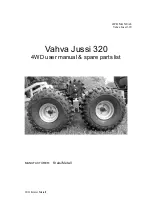
Owner’s Manual
Controlling from an external MIDI keyboard Assigning Control numbers
46
Quic
k Guide
For example, in the instructions below, we'll control panning with
an external assignable controller.
1.
Select the “Set1Source” parameter to “AS1” (ASSIGN 1)
in the CtrlSet display, then confirm the Control Number
of the “AS1.”
n
For the source parameters, refer to “Set1-6Source” on page 66.
n
You can change the Control Number corresponding to the source
controller (see right).
2.
On the external controller device, make sure that the
“AS1” setting matches the Control Number generated
by operating the relevant controller.
For details on how to do this, refer to the owner’s manual of your
particular device.
3.
Set the “Set1Dest” parameter to “ELM-Pan (Element
Pan).”
n
For details on the available Dest parameter settings, refer to the Control
List in the separate Data List booklet.
4.
Set the depth of control by changing the “Set1Depth”
parameter setting.
5.
Repeat Steps 1 and 3 above to assign the remaining
Control Sets 2 through 6.
6.
The assigned functions (Destinations) are operated by
operating the external controller.
n
The Controller Set edited in the Voice Edit mode is available when the
corresponding Voice is selected in the Performance mode and Multi mode.
n
In the Performance mode, controls the Voice assigned to each Part depending
on the Controller sets made in the Voice mode. In Multi mode, controls the
Part(s) assigned the same channel as the channel of the MIDI message
generated by operating an external controller.
Controlling the overall system with ASSIGN
A and B
The ASSIGN A and B (ASA and ASB) settings let you control the
functions that affect all Voices, Performances, and Multis.
1.
Move the cursor to “ASA Asgn” and “ASB Asgn”
parameters, then confirm the Control Numbers.
n
You can change the Control Number corresponding to the source
controller (see below).
2.
Select the destinations of the ASA and ASB controllers
with the “ASA Dest” and “ASB Dest” parameters.
3.
Assign each Control Number of “ASA Asgn” and “ASB
Asgn” to an external controller device.
4.
The assigned functions (Destinations) can be
controlled in all modes by operating the external
controller.
Assigning Control numbers
Each external controller has a pre-assigned Control Change
number. When operating the external controller, each Control
Change message assigned to each controller is transmitted to the
MOTIF-RACK ES. Then, the Destination (function) corresponding
to the Control Number is operated.
For example, if you assign the same Control Number as the AS1 to
one external controller, you can operate the Destination (function)
of the AS1 by the controller.
The following list indicates how to assign the Control Numbers to
the controller (source) of the MOTIF-RACK ES.
* This controller is not used in the Controller Set function
n
The actual MIDI message may differ depending on the external controller
settings.
Using one source to control several destinations
For example, set the Source parameter of Control Set 1 to MW
(Modulation Wheel) and the Destination parameter to ELFO-PM
(Element LFO Pitch Modulation Depth). Then set the Source
parameter of Control Set 2 also to MW, but set the Destination
parameter to ELM PAN (Element Pan). In this example, when you
move the Modulation Wheel upward, the amount of Pitch
Modulation increases accordingly, and the Element is panned
from left to right. In this way, you can have the sound change in
several different ways, simply by adjusting a single controller.
Using several sources to control one destination
For example, set the Source parameter of Control Set 1 to MW
(Modulation Wheel) and the Destination parameter to ELFO-PM
(Element LFO Pitch Modulation Depth). Then set the Source
parameter of Control Set 2 to FC (Foot Controller) and set the
Destination parameter also to ELFO-PM (Element LFO Pitch
Modulation Depth). Now, Pitch Modulation is assigned to both the
Modulation Wheel and Foot Controller. This can be useful in live
performance situations, letting you use any one of several
controllers depending on which is convenient at the time. In this
way, you can have several different controllers affect the same
aspect of the sound.
Control Number
Voice mode
→
[UTILITY]
→
CtrlAsn display
→
“ASA/B Asgn,” “ASA/B Dest”
Controller
Generated
MIDI message
Display
Aftertouch
(AT)
Channel
Aftertouch (DnH)
—
Pitch Bend Wheel
(PB)
Pitch Bend (EnH)
—
Modulation Wheel
(MW)
Control Change
(BnH, 01H)
—
Assignable Controller
(ASA, ASB)*
Control Change
(BnH)
[UTILITY]
→
CtrlSet display
→
ASA
Asgn, ASB Asgn
Footswitch
(FS)
Control Change
(BnH)
[UTILITY]
→
CtrlSet display
→
FS
Asgn
Ribbon Controller
(RB)
Control Change
(BnH)
Voice mode (Settings affecting all
Voices): [VOICE]
→
[UTILITY]
→
Voice display
Performance/Multi mode (Settings
affecting each Performance/Multi):
[SHIFT] + [PERFORMANCE]/
[MULTI]
→
select Performance/Multi
→
[EDIT]
→
[SHIFT]+[COMMON]
→
CtrlAsn display
Assignable Controller
(AS1, AS2)
Foot Controller
(FC1, FC2)
Breath Controller
(BC)
Содержание MOTIF RACK ES
Страница 1: ...OWNER S MANUAL TONE GENERATOR EN ...
Страница 110: ...Owner s Manual 110 Appendix Memo ...
















































